Thickness Impact on the Morphology, Strain Relaxation and Defects of Diamond Heteroepitaxially Grown on Ir/Al2O3 Substrates
Abstract
:1. Introduction
2. Experimental
3. Results and Discussion
4. Conclusions
Author Contributions
Funding
Institutional Review Board Statement
Informed Consent Statement
Data Availability Statement
Conflicts of Interest
References
- Isberg, J.; Hammersberg, J.; Johansson, E.; Twitchen, D.J.; Whitehead, A.J. High Carrier Mobility in Single-Crystal Plasma-Deposited Diamond. Science 2002, 297, 1670–1673. [Google Scholar] [CrossRef]
- Saha, N.C.; Kim, S.W.; Oishi, T.; Kawamata, Y.; Koyama, K.; Kasu, M. 345-MW/cm2 2608-V NO p-Type Doped Diamond MOSFETs with an AlO Passivation Overlayer on Heteroepitaxial Diamond. IEEE Electron Device Lett. 2021, 42, 903–906. [Google Scholar] [CrossRef]
- Matsumae, T.; Kurashima, Y.; Umezawa, H.; Mokuno, Y.; Takagi, H. Room-temperature bonding of single-crystal diamond and Si using Au/Au atomic diffusion bonding in atmospheric air. Microelectron. Eng. 2018, 195, 68–73. [Google Scholar] [CrossRef]
- Donato, N.; Rouger, N.; Pernot, J.; Longobardi, G.; Udrea, F. Diamond power devices: State of the art, modelling, figures of merit and future perspective. J. Phys. D Appl. Phys. 2020, 53, 093001. [Google Scholar] [CrossRef] [Green Version]
- May, P.W. Materials science: The new diamond age? Science 2008, 319, 1490–1491. [Google Scholar] [CrossRef]
- Schreck, M.; Gsell, S.; Brescia, R.; Fischer, M. Ion bombardment induced buried lateral growth: The key mechanism for the synthesis of single crystal diamond wafers. Sci. Rep. 2017, 7, 44462. [Google Scholar] [CrossRef] [PubMed]
- Schreck, M.; Roll, H.; Stritzker, B. Diamond/Ir/SrTiO3: A material combination for improved heteroepitaxial diamond films. Appl. Phys. Lett. 1999, 74, 650–652. [Google Scholar] [CrossRef]
- Ohtsuka, K.; Fukuda, H.; Suzuki, K.; Sawabe, A. Fabrication of epitaxial diamond thin film on iridium. Jpn. J. Appl. Phys. Part 2 Lett. 1997, 36, L1214–L1216. [Google Scholar] [CrossRef]
- Aida, H.; Kim, S.W.; Ikejiri, K.; Kawamata, Y.; Koyama, K.; Kodama, H.; Sawabe, A. Fabrication of freestanding heteroepitaxial diamond substrate via micropatterns and microneedles. Appl. Phys. Express 2016, 9, 035504. [Google Scholar] [CrossRef]
- Sawabe, A.; Fukuda, H.; Suzuki, T.; Ikuhara, Y.; Suzuki, T. Interface between CVD diamond and iridium films. Surf. Sci. 2000, 467, 845–849. [Google Scholar] [CrossRef]
- Gsell, S.; Bauer, T.; Goldfuß, J.; Schreck, M.; Stritzker, B. A route to diamond wafers by epitaxial deposition on silicon via iridium/yttria-stabilized zirconia buffer layers. Appl. Phys. Lett. 2004, 84, 4541–4543. [Google Scholar] [CrossRef]
- Fischer, M.; Gsell, S.; Schreck, M.; Brescia, R.; Stritzker, B. Preparation of 4-inch Ir/YSZ/Si(001) substrates for the large-area deposition of single-crystal diamond. Diam. Relat. Mater. 2008, 17, 1035–1038. [Google Scholar] [CrossRef]
- Gsell, S.; Fischer, M.; Brescia, R.; Schreck, M.; Huber, P.; Bayer, F.; Stritzker, B.; Schlom, D.G. Reduction of mosaic spread using iridium interlayers: A route to improved oxide heteroepitaxy on silicon. Appl. Phys. Lett. 2007, 91, 89–92. [Google Scholar] [CrossRef]
- Tallaire, A.; Brinza, O.; Mille, V.; William, L.; Achard, J. Reduction of Dislocations in Single Crystal Diamond by Lateral Growth over a Macroscopic Hole. Adv. Mater. 2017, 29, 1–5. [Google Scholar] [CrossRef] [PubMed]
- Umezawa, H.; Kato, Y.; Watanabe, H.; Omer, A.M.M.; Yamaguchi, H.; Shikata, S.I. Characterization of crystallographic defects in homoepitaxial diamond films by synchrotron X-ray topography and cathodoluminescence. Diam. Relat. Mater. 2011, 20, 523–526. [Google Scholar] [CrossRef]
- Schreck, M.; Schury, A.; Hörmann, F.; Roll, H.; Stritzker, B. Mosaicity reduction during growth of heteroepitaxial diamond films on iridium buffer layers: Experimental results and numerical simulations. J. Appl. Phys. 2002, 91, 676–685. [Google Scholar] [CrossRef]
- Wei, Q.; Niu, G.; Wang, R.; Chen, G.; Lin, F.; Zhang, X.; Zhang, Z.; Wang, H.X. Heteroepitaxy of single crystal diamond on Ir buffered KTaO3 (001) substrates. Appl. Phys. Lett. 2021, 119, 092194. [Google Scholar] [CrossRef]
- Zaitsev, A.M.; Kosaca, G.; Richarz, B.; Raiko, V.; Job, R.; Fries, T.; Fahrner, W.R. Thermochemical polishing of CVD diamond films. Diam. Relat. Mater. 1998, 7, 1108–1117. [Google Scholar] [CrossRef]
- Jiang, X.; Rickers, C. Defect examination of diamond crystals by surface hydrogen-plasma etching. Appl. Phys. Lett. 1999, 75, 3935–3937. [Google Scholar] [CrossRef]
- Ichikawa, K.; Kodama, H.; Suzuki, K.; Sawabe, A. Dislocation in heteroepitaxial diamond visualized by hydrogen plasma etching. Thin Solid Films 2016, 600, 142–145. [Google Scholar] [CrossRef]
- Gallheber, B.C.; Klein, O.; Fischer, M.; Schreck, M. Propagation of threading dislocations in heteroepitaxial diamond films with (111) orientation and their role in the formation of intrinsic stress. J. Appl. Phys. 2017, 121, 225301. [Google Scholar] [CrossRef]
- Kim, S.W.; Kawamata, Y.; Takaya, R.; Koyama, K.; Kasu, M. Growth of high-quality one-inch free-standing heteroepitaxial (001) diamond on (11 2−0) sapphire substrate. Appl. Phys. Lett. 2020, 117, 202102. [Google Scholar] [CrossRef]
- Motzer, C.; Reichling, M. Morphological classification and quantitative analysis of etch pits. J. Appl. Phys. 2010, 108. [Google Scholar] [CrossRef]
- Ichikawa, K.; Kodama, H.; Suzuki, K.; Sawabe, A. Effect of stripe orientation on dislocation propagation in epitaxial lateral overgrowth diamond on Ir. Diam. Relat. Mater. 2017, 72, 114–118. [Google Scholar] [CrossRef]
- Washington, M.A.; Cummins, H.Z. Linewidth of the sharp two-phonon Raman peak in diamond. Phys. Rev. B 1977, 15, 5840–5842. [Google Scholar] [CrossRef]
- Mehmel, L.; Issaoui, R.; Brinza, O.; Tallaire, A.; Mille, V.; Delchevalrie, J.; Saada, S.; Arnault, J.C.; Bénédic, F.; Achard, J. Dislocation density reduction using overgrowth on hole arrays made in heteroepitaxial diamond substrates. Appl. Phys. Lett. 2021, 118, 061901. [Google Scholar] [CrossRef]
- Ferrari, A.C.; Robertson, J. Origin of the 1150-cm−1 Raman mode in nanocrystalline diamond. Phys. Rev. B—Condens. Matter Mater. Phys. 2001, 63, 121405. [Google Scholar] [CrossRef]
- Prawer, S.; Nemanich, R.J. Raman spectroscopy of diamond and doped diamond. Philos. Trans. R. Soc. A Math. Phys. Eng. Sci. 2004, 362, 2537–2565. [Google Scholar] [CrossRef]
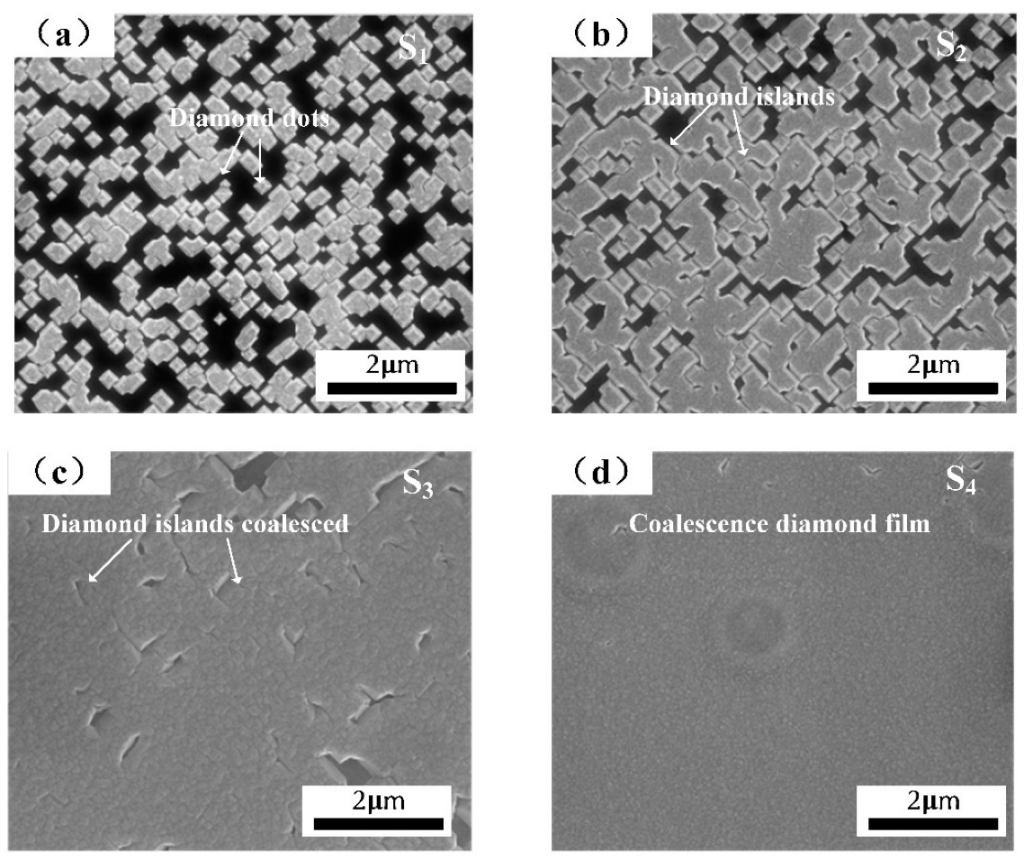
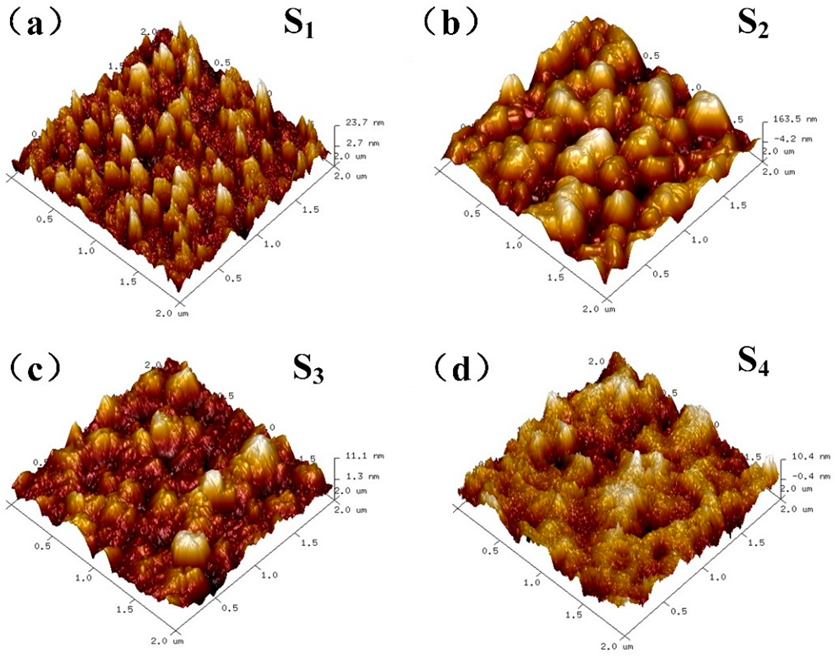
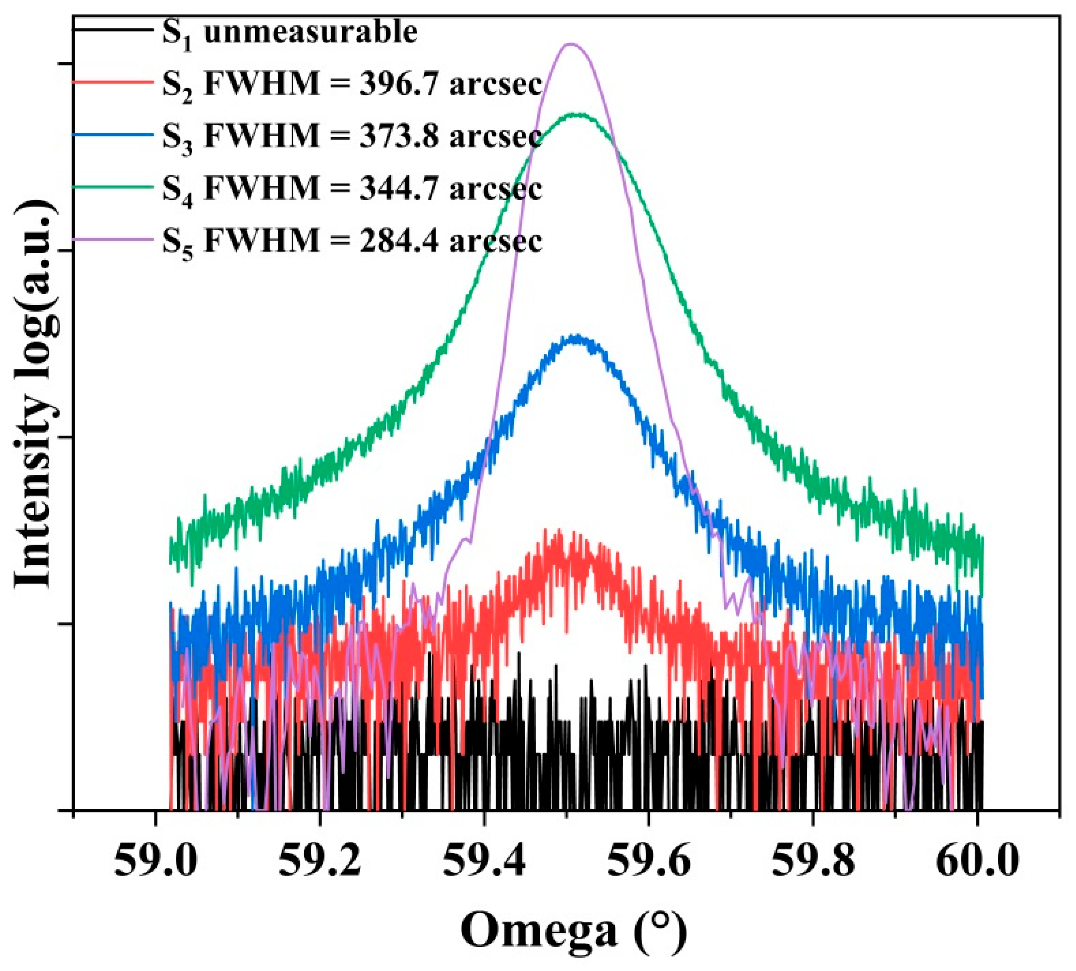
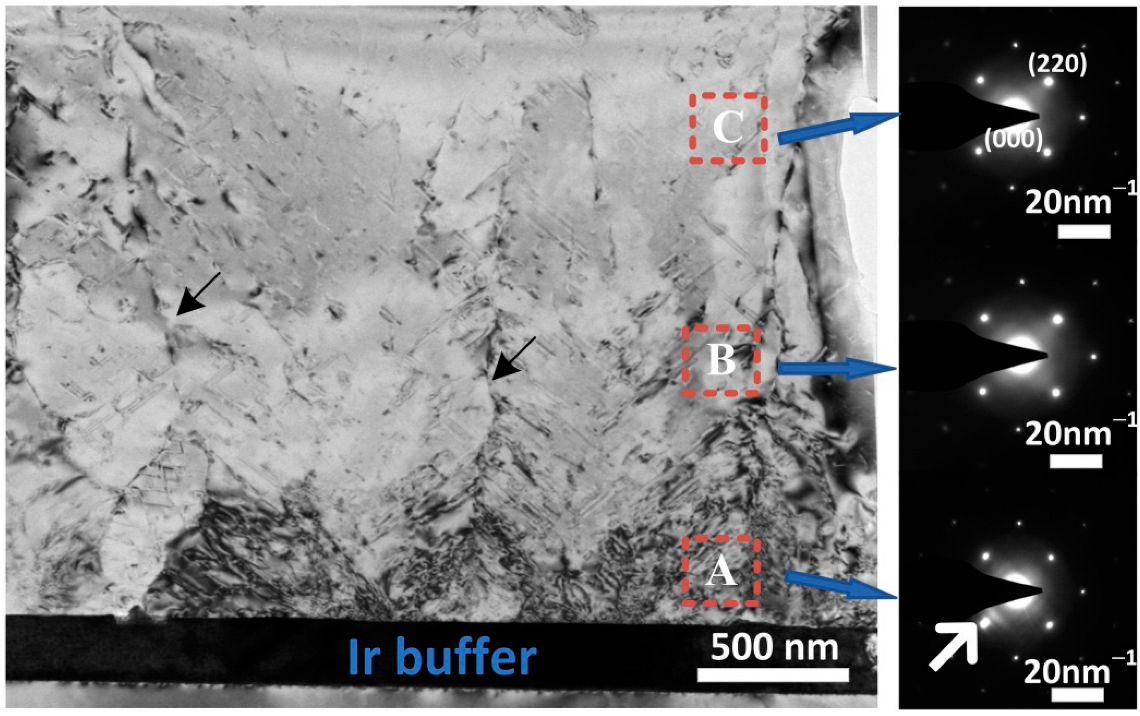
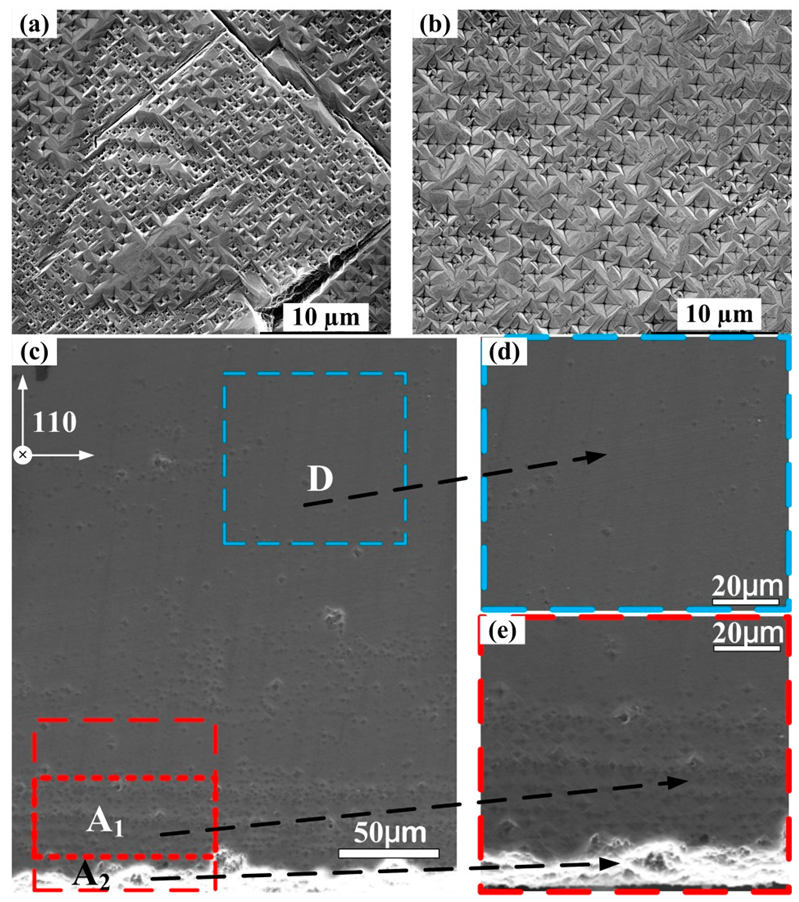
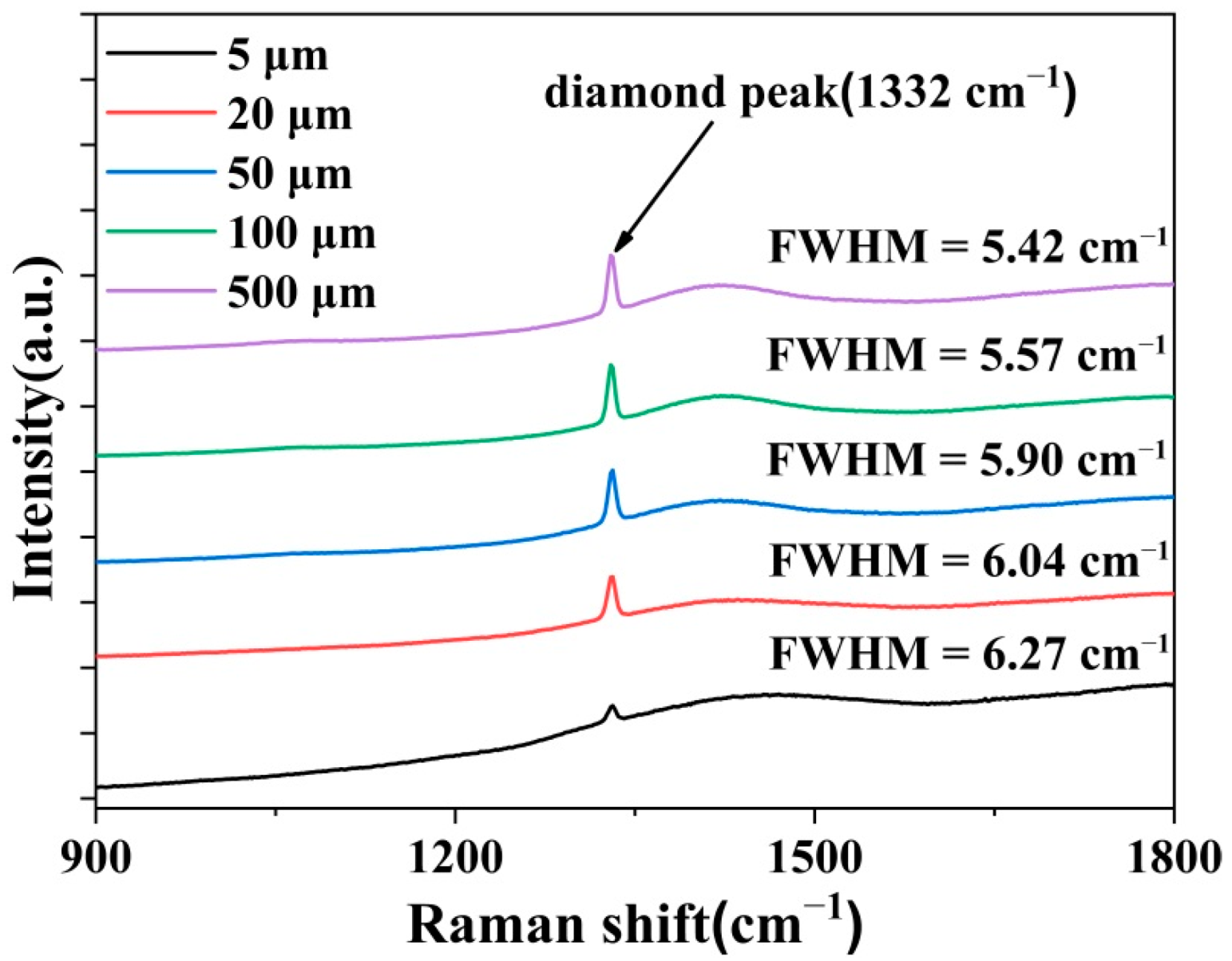
Publisher’s Note: MDPI stays neutral with regard to jurisdictional claims in published maps and institutional affiliations. |
© 2022 by the authors. Licensee MDPI, Basel, Switzerland. This article is an open access article distributed under the terms and conditions of the Creative Commons Attribution (CC BY) license (https://creativecommons.org/licenses/by/4.0/).
Share and Cite
Wang, R.; Lin, F.; Wei, Q.; Niu, G.; Wang, H.-X. Thickness Impact on the Morphology, Strain Relaxation and Defects of Diamond Heteroepitaxially Grown on Ir/Al2O3 Substrates. Materials 2022, 15, 624. https://doi.org/10.3390/ma15020624
Wang R, Lin F, Wei Q, Niu G, Wang H-X. Thickness Impact on the Morphology, Strain Relaxation and Defects of Diamond Heteroepitaxially Grown on Ir/Al2O3 Substrates. Materials. 2022; 15(2):624. https://doi.org/10.3390/ma15020624
Chicago/Turabian StyleWang, Ruozheng, Fang Lin, Qiang Wei, Gang Niu, and Hong-Xing Wang. 2022. "Thickness Impact on the Morphology, Strain Relaxation and Defects of Diamond Heteroepitaxially Grown on Ir/Al2O3 Substrates" Materials 15, no. 2: 624. https://doi.org/10.3390/ma15020624





